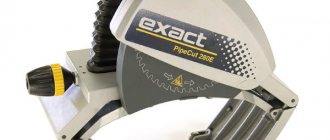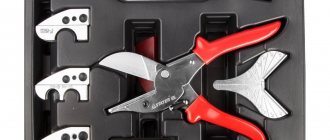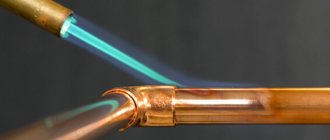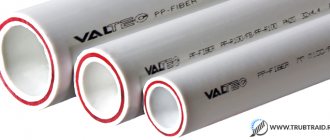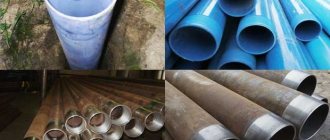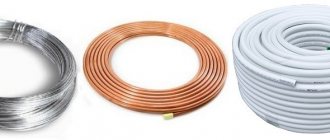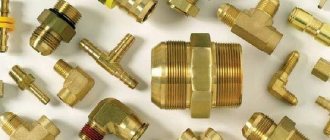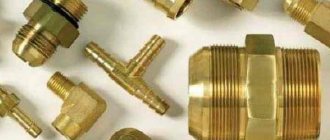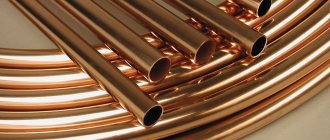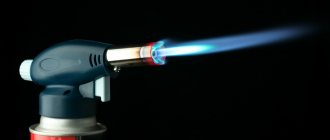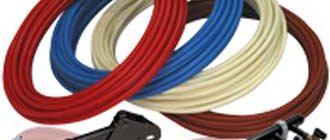Back in the 20-30s of the last century, copper pipes were used everywhere for the water supply system. This metal has been known to mankind for a long time, as well as its well-known alloys (bronze and brass). Even after a century, copper pipes have not lost their relevance; they are still used for plumbing today.
Copper pipes: distinctive features
Copper pipes are produced in five-meter lengths. They are twisted into compact coils from 20 to 50 meters. If we compare them with steel pipes, then copper pipes with an increased diameter have a small wall thickness. Such TV pipes are several times lighter and more convenient than their steel counterparts. They can also withstand quite high operating pressures when compared to steel pipes.
Copper pipes are characterized by very smooth walls, and their roughness is 100 times lower than that of steel pipes. This means that this particular pipeline has a high throughput capacity throughout its entire service life.
Today, the domestic market offers a material that consists of copper on the inside and is coated with polymer on the outside. This is needed more for aesthetic beauty. The thing is that the polymer can take on a variety of shades, which means that the water supply can also be made in different colors. In addition, the polymer coating protects the pipe material from the harmful effects of moisture, elevated temperature, light or chemicals. This is especially true when you have to lay a water supply system in the ground.
Where are copper pipes used?
Such pipes are used for installation of heating systems, since copper has high thermal conductivity and durability. They are also widely used for pipelines that transport various gases and oils. Such pipes are also indispensable for the installation of air conditioning and ventilation systems.
However, copper pipe is especially in demand for installing a water supply system. Moreover, they can be used for both hot and cold water supply.
Secrets of installing a copper pipe
Laying the material is easy because it bends easily. You can use copper fittings with soldering to connect the pipeline. You can also press fit with an O-ring.
It is impossible to install copper pipes without soldering. Soft solder is used to connect pipes for hot and cold water supply. The pipes can withstand operating temperatures up to 110 degrees.
Thermostatic mixers - for greater comfort and safety!
How is pressure testing of a heating system performed?
Source: www.684015.ru
Applications of copper pipes
Copper pipes have long taken their rightful place in pipeline construction. They successfully compete with such modern materials as plastic and metal-plastic pipes.
Where are copper pipes used?
Such pipes are used in water supply installations; they can also be used for drinking water. Copper pipes can be used as heating pipes, both using solar energy and any type of fuel (liquid, gas). This type of pipe is also used for drainage. It should not be forgotten that the price of a copper pipe is high.
Galvanized steel pipes
Traditional solution.
Steel plumbing pipes are found in many homes built 15 years ago or more. The pipes are made of high-carbon steel, coated inside and outside with zinc to protect against corrosion.
Subject to corrosion at joints.
This is their main drawback. During the welding process, the protective zinc coating evaporates and the steel comes into contact with water. The same thing happens with threaded connections: threading also breaks the galvanization.
Service life does not exceed 20 years.
Corrosion leads to leaks at joints, and water acquires a metallic taste.
The price is not high and depends on the diameter.
For example, a pipe with an internal diameter of 25 mm will cost no more than 200 rubles per linear meter.
Advantages of copper pipes:
1. Do not corrode.
2. Very flexible.
3. Do not cause inconvenience during installation.
4. Copper has bactericidal properties.
5. They are not afraid of frost (do not crack), as well as very high temperatures (do not melt, do not deform).
6. Long service life, more than 50 years.
7. They are not afraid of chlorinated water.
8. Not subject to the formation of limescale.
9. It tolerates sudden temperature changes very well.
10. Sealed. If you use them as gas pipes, then you don’t have to be afraid, it will never let gas out.
11. They are not afraid of sunlight.
12. Can be painted in any color to give a more aesthetic appearance.
13. Even pipes with a small diameter have a large throughput.
14. They have high thermal conductivity, therefore they are often used for “warm floors”.
Polypropylene pipes
If the budget allocated for construction is not too large, then polypropylene pipes would be a good option for arranging a water supply system. They are cheaper than other polymer products, and in some places they even surpass them in characteristics: the operating temperature of polypropylene is +95 degrees, and the pressure is up to 20 atmospheres. In addition, it is worth noting the service life, which on average is about 50 years. All that remains is to decide which polypropylene pipes are better in order to make the final choice.
The disadvantage of polypropylene products is the lack of plasticity, so installation of the pipeline at an angle is possible only with the help of appropriate fittings. Permanent connections of such pipes are made using a special soldering iron. In any case, before purchasing, you need to carefully understand which propylene pipes are best for water supply, and prepare the equipment necessary for installation.
Disadvantages of copper pipes:
1. Copper pipes cannot be connected to steel pipes.
2. The water that will flow through the pipe must be free of harmful impurities and nitrates, otherwise deposits may form.
3. The price of a copper pipe is higher than that of a plastic or metal-plastic pipe.
4. Connecting parts for pipe installation (all kinds of fittings) are not cheap.
If you have chosen copper pipes, be sure to consult with specialists about the rules of their operation. With proper use and proper care, such pipes will last you a very long time.
© 2012-2013 HomeProrab. All rights are of course reserved. When copying, a backlink to the site is required.
Source: homeprorab.info
Results
As you can see, copper pipes for heating are a good, but not ideal option. This material has many advantages, but no less disadvantages. Corrosion may occur - this may be the result of an incorrectly selected coolant composition, high pressure or water hammer. Moreover, it is worth considering that the service life of copper heating systems directly depends on proper design and installation, that is, even if high-quality components are used, but they are soldered or laid with “crooked” hands, there will be no long-term operation. And today there are very few specialists who competently work with copper, and their services (in addition to the materials) are also very expensive. Perhaps this is why they rarely install it today, especially since there is a good replacement - polypropylene (reinforced) or metal-plastic.
Finally, a few video lessons with useful information. This video has a little about the types of solders.
And this video material talks about how copper fittings are made. Interesting…
Features of copper pipes
When it comes to performance characteristics, copper is a practical and reliable material. Copper pipes have the following beneficial properties:
- High temperature resistance. Copper pipes for heating systems can withstand temperatures from −100ºC to +250 ºC.
- Copper pipes are not afraid of pressure up to 30 atmospheres or more. Due to their plasticity, they will not collapse, even if the water in them freezes.
- Copper is resistant to corrosion, it does not react to ultraviolet radiation and active chemicals contained in coolants of general networks. The service life of copper pipes reaches 100 years.
- Compared to polymers, the coefficient of thermal expansion of copper is lower. Therefore, it is used at the outlet of heat generators.
- Low roughness of the inner surface of pipes reduces hydraulic resistance in pipeline systems. Therefore, to work in such systems, copper pipes of smaller diameter are required than in the case of steel products. This also prevents deposits from accumulating inside copper pipes.
- Copper pipes are harmless to humans and have antibacterial properties.
For these reasons, copper pipes have been valued by people for many millennia.
Disadvantages of copper and products made from it
Of course, like any other building material, copper pipes have some disadvantages, among which are:
- High cost of copper products.
- Quite high electrical conductivity of the material. As a result, the pipeline may suffer as a result of the influence of stray currents on it.
- When passing products through a wall, special protective covers must be used. This is done in order to protect the pipeline from the negative effects of structures.
- Copper and aluminum products cannot be used simultaneously in the same pipeline. This may cause galvanic corrosion.
- If we are talking about steel pipes, then they should be located in front of copper products. This will reduce the risk of corrosion processes.
Quality proven over 5 millennia
Copper is one of the most reliable and durable metals. The earliest metal water pipes were found in Egypt. Fragments of the first pipe designed to drain rainwater were also found there. It consisted of links made of sheet metal. No rivets, folding or soldering were used to connect the pipe pieces. They were connected “overlapping”: the fragments were narrowed at one end, each link was inserted and securely fixed into the previous one. The estimated time for the creation of such a pipeline is 2500 BC. e.
Main characteristics of copper and its use in different industries
Nowadays, copper products are widely used in many areas: for plumbing, heating, gas pipelines. Copper tube is one of the most significant elements when installing air conditioning systems and refrigeration equipment.
The thermal conductivity of copper is another advantage. High thermal conductivity makes it possible to use copper pipes in various heat-conducting devices. Due to its high technical characteristics, copper has practically no equal.
Where are copper pipes used?
In the industrial field, copper pipes are used everywhere: from crystallizers to radar and solar systems, heat pumps. The same applies to the domestic sphere - you can find copper pipes in almost any part of the house, because with their help they are created:
- hot and cold water supply pipelines;
- heating systems;
- warm floor;
- refrigeration equipment;
- air conditioning systems.
This is also explained by the reliability of copper pipes. Also, copper pipes used in hot or cold water supply pipelines can be connected without the risk of corrosion to pipes made of other materials: brass, plastic and steel.
Copper products with insulating coating
Among other things, copper pipes may have an additional insulating layer. Depending on this, they are divided into several types:
- Products with foam insulation based on rubber, polyurethane foam and polyethylene foam. Such pipes are used to reduce heat loss in heating and hot water supply systems. The thickness of the insulating layer will reach 3 cm.
- Copper pipes with a polyethylene coating, the thickness of which reaches 2.5 mm. Products often have a diameter of 12 – 54 mm. Often used in heating and cold water supply systems.
- Products with polyethylene insulation up to 3 mm thick. Pipes are laid using a hidden method in a monolithic structure. The product has design features that allow you to maintain the integrity of the pipeline during temperature fluctuations.
Copper pipes are not subject to corrosion processes. Therefore there is no need to apply a protective layer. But, as for additional insulation, it will not be superfluous, especially when it comes to the construction of a heating and water supply system. Especially often, such pipes are used for laying external networks that are subject to severe loads under the influence of the external environment.
Supply of copper pipes
Whatever copper pipes you need - for water supply and heating, for refrigeration equipment, air conditioning systems or for heat exchange equipment - you can order them from the UMMC-OTsM company.
Products meet the requirements of world and national standards. Production is carried out at the Revdinsky Non-Ferrous Metals Processing Plant. You can order copper pipes both wholesale and retail. Delivery to any city in Russia is possible.
Source: www.ocm.ru
Advantages of copper water supply, comparison of copper, steel, plastic and polypropylene pipes
For the installation of water supply systems in Russia today, metal-plastic and polypropylene pipes are often used. Copper is the last thing people remember. In Europe, this material has been used for sanitary equipment in buildings since the 19th century. This home equipment includes cold and hot water pipelines, sewer and gas pipes, water heating devices, and gas appliances.
In a number of countries, after a period of rapid growth in the popularity of plastic pipes, a reverse trend has emerged - a return to copper pipes. Both developers and home buyers have already noted a significantly lower frequency of accidents when using copper pipes during the first years of operation.
Reliability of water pipes depending on the material
Water supply and heating systems are among the most expensive utilities. The level of costs required to maintain such systems in the future depends on the reliability of the materials used. Steel pipes, widespread in Russia today, have long raised a lot of questions from both specialists and ordinary consumers - such pipes rust, leak and do not have a long service life.
The plastic pipes that replaced them also justified themselves only in terms of cheapness. In practice, they turned out to be not the best solution: a VTsIOM study conducted in 2006 found that in the first 3 years of using plastic pipes, accidents occur in 8 out of 100 apartments (using the example of the Saratov housing stock). In this case, harm is caused both directly to apartment owners and neighbors. For homeowners, the initial savings on pipes led to additional costs for repairs both in their own and neighboring apartments. The costs of repairing such pipes in case of accidents fall on the owners of apartments and houses.
The study showed that copper pipes have serious advantages over other types of water pipes in terms of price-quality ratio.
Advantages of copper pipes
The advantages of copper pipes are explained by the natural properties of copper. Among them:
- Anti-corrosion properties. When copper interacts with chlorinated water, a durable layer of patina is formed, which further extends the life of such pipes, which cannot be said about plastic pipes. Copper pipes are guaranteed to last for many years. The service life of copper is between 50 and 100 years.
- Good thermal conductivity. Due to the high thermal conductivity of copper - 401 W/(m*C) - copper pipes are often used in heating systems. In water supply systems, they can be used in a PVC shell - this helps to avoid heat loss.
- Bactericidal properties. Water passing through copper water pipes is partially disinfected. There is no talk of complete purification, but copper pipes are often used in biological water treatment systems as an additional cleaning element.
- Plastic. Due to the elasticity of copper, water pipes made from it are plastic, easy to process and resistant to temperature changes.
Copper pipes withstand temperatures from -100ºC to +250ºC and pressure up to 200 atm, and are not destroyed by repeated freezing and thawing. Through them, harmful substances, gases and odors will not enter the water.
Do copper pipes have any disadvantages?
Among the disadvantages attributed to copper pipes, the main one is their high cost in comparison with plastic or steel products. In fact, copper pipes are one of the most economical solutions, as their service life reaches 50-100 years and more than covers the costs. Compared to the total amount it costs to renovate an average city apartment, the cost of water supply from copper pipes is relatively small.
The disadvantage of copper pipes is the complexity of installation. Soldering copper water pipes is a job that requires certain skills, but welding steel pipes using an acetylene torch is no easier. But comparing copper pipes with other types of water pipes is a topic that deserves separate consideration.
Comparison of copper, steel and polypropylene pipes
When choosing a material for water pipes, they are guided by the average service life, performance properties and installation complexity. We will focus on these qualities:
- Lifetime. The service life of copper pipes ranges from 50 to 100 years. Polypropylene pipes are not able to compete with them even with strict adherence to temperature conditions. At a temperature of +75 °C and a pressure of 7.5 atmospheres (average temperature and pressure in heating systems of high-rise buildings in winter), the service life of polypropylene pipes will be a maximum of 20-25 years.
- As for galvanized steel pipes, their durability depends on the quality of the metal and workmanship, on water, its acidity and aggressiveness towards the metal. Steel pipes will last a maximum of 15-20 years.
- Installation. You can connect the parts of a copper water supply in several ways: using union nuts and pipe flaring, or by soldering. Most often, soldering is used for these purposes, performed using special torches, solders and fluxes. If you have experience, you can connect the parts of a copper water supply using a regular blowtorch. As for metal-plastic pipes, a set of tools consisting of pipe cutting scissors, a calibrator, an adjustable wrench, open-end wrenches, pliers and a drill is sufficient for their installation. To install polypropylene pipes, you will also need special scissors and equipment for socket welding - a heater or soldering iron.
Using copper pipes in various piping systems - pros and cons
Despite the fact that plastic communications are everywhere replacing metal ones, copper pipe remains a priority for the arrangement of communications for zealous owners. Copper products are also used in production, for example, for transporting gases under pressure or when operating pipelines at high temperatures.
To install copper communications, you should know the characteristics of the material, diameter markings for selecting fittings, and the compatibility of European and domestic products.
Strengths and weaknesses of copper plumbing
Copper pipes are similar to their closest competitors (steel communications) in terms of strength and temperature characteristics. However, copper is more preferable due to its unique properties.
The main advantages of copper pipes
Copper pipes have their positive and negative aspects. First, let's look at the advantages of copper piping.
Corrosion resistance and ductility
Perhaps the main argument in favor of copper plumbing is its immunity to rust. This property explains the duration of uninterrupted operation of utility networks and minimizes the negative impact on plumbing fixtures.
Plasticity - this quality explains a number of significant operational advantages of a copper pipeline:
- flexibility of the material in processing - pipes can be bent to create complex trunk networks using hand tools;
- retention of a given shape - soft polymer products cannot boast of this property;
- possibility of using connecting fittings;
- probability of deformation without mechanical destruction;
- temperature jumps do not cause changes in linear parameters;
- withstands freeze/thaw cycles while maintaining integrity.
Another point is increased resistance to water hammer. The indicator of destructive pressure allows you not to fear for the integrity of the system during “jumps” in water pressure.
Surface smoothness and bactericidal properties
An archival argument in favor of copper plumbing. The high homogeneity of the material ensures a perfectly even coating, which reduces the molecular bonds of the metal, which means the formation of salts and oxides is reduced.
Copper alloy has antibacterial properties - as water circulates through the pipes, it is partially disinfected. An additional plus is that colonies of microorganisms do not multiply on the walls.
Resistance to chemicals and UV rays
Copper is not destroyed when interacting with saline solutions, formalion and dilute non-oxidizing acids. When in contact with chlorine, it does not form oxides hazardous to humans.
Copper does not lose its characteristics under the influence of UV radiation, which cannot be said about communications made of thermoplastic polymers.
Along with good strength indicators, copper alloy pipes are somewhat lighter in weight than their steel counterparts. This makes them easier to transport and install. The indisputable advantage of a copper pipeline is the possibility of repeated use.
Disadvantages of a copper pipeline
The copper pipeline also has its negative aspects. Let's look at them in more detail.
The disadvantages of copper water pipes include:
- High price. When compared with the cost of analogues, copper products lose out. Setting up a network made of “yellow” metal will cost several times more than installing a plastic or steel main line.
- Labor intensive installation. All technologies for joining copper fittings (assembly on fittings or soldering) are quite complex processes that require operational skills.
- Acid intolerance. Copper pipes cannot be used to transport acidic media with a pH level of more than 9. Water with this indicator is not suitable for drinking.
- Thermal conductivity. The parameter is 1.7 times higher than that of aluminum products and almost six times higher than the thermal conductivity of steel. When transporting a hot medium, the pipe heats up - heat losses increase, and there is a risk of burns. In cold water supply systems, condensation forms on the pipeline.
The problem can be solved by using a coating made of polyvinyl chloride or polyethylene. The outer sleeve prevents condensation, “cools” the surface, maintains the temperature of the transported medium and reduces noise.
Copper pipes with external thermal insulation are used only in cases where it is necessary to reduce the impact of the external environment on the water supplied by the system. They are also needed to prevent ice jams that can disrupt the functionality of the water supply system.
The copper pipes themselves are not threatened by the processes of freezing and subsequent thawing. The plasticity of copper allows it to maintain tightness even if the pipeline had to be slightly deformed under the influence of an ice plug.
Additional disadvantages of using rolled copper are electrical conductivity, as well as incompatibility with aluminum and steel elements of the water supply system. To prevent the risk of electric shock, care should be taken to properly ground the equipment during installation.
A significant disadvantage of copper pipes is the occurrence of electrochemical corrosion, which appears as a result of contact of copper with other materials:
Characteristics of the material
Copper is a chemically inert metal. Unlike steel, it does not corrode, has greater ductility and a smooth surface. Due to chemical resistance to external influences, copper pipelines can last about 80 years without replacement.
A greenish copper carbonate or patina forms on the surface of the metal. This plaque acts as a natural protective layer, so it is not recommended to clean it off.
Note! Patina is an indicator of the antiquity of the product and is considered a completely aristocratic touch. In the modern design world, patina is obtained artificially to give things nobility.
The only drawback of copper pipes and fittings is their high cost. However, the money spent will allow you to forget about problems with water supply or heating forever.
Copper communications are not susceptible to either external or internal deformation. For the production of pipes and components, special, purified copper is used, which consists of 99.9% chemically pure metal. To give copper an aesthetic appearance, they are chrome-plated or painted.
Benefits of using copper
modern plastic cannot compare in strength and wear resistance
Copper is mainly used for its technological properties.
- The main advantage of copper material is its resistance to high temperatures. When the temperature reaches 600 degrees, the structure of the metal changes and becomes hard, but elastic. The melting point is about 1084 degrees. This allows the use of copper pipelines not only for laying a hot water system, but also for heating.
- This metal is also distinguished by good thermal conductivity, which means that the use of copper in heating, cooling systems, or even in computer coolers is completely justified.
- Copper is a unique natural material that does not become covered with a corrosive coating, even after a huge period of time. Only a thin green coating may appear, which can be easily removed with a damp cloth. Limescale does not settle on the inner walls of the pipes. Given these two characteristics of the material, the pipes have thin wall thickness.
- Pipes and fittings made of copper material have bactericidal properties, so you don’t have to worry that mold or mildew will begin to form on the pipeline over time.
- Unlike other metals, copper material, due to its flexibility, is very easy to install in a box or walls, and you don’t have to be afraid that the pipe will crack or burst somewhere.
In addition to the plumbing and gas industries, this metal is also used in electrical engineering, architecture, and equipment manufacturing.
How are copper pipes made?
There are two production methods:
Seamless copper pipe production is more common. The essence of manufacturing is to cold-roll a blank copper sleeve to the required diameter. For this:
- A copper bar is heated and a hole is made in it on a special mill - a piercing machine. A blank sleeve is obtained. The size of the blank and sleeve depends on the desired diameter of the future product.
- The sleeve is rolled on special machines, increasing the diameter to the desired size. When making a large-diameter copper pipe, the blank or sleeve may be heated several times.
The production of welded copper pipe is carried out using sheet material, which is wound onto a workpiece of the required size. The seam is welded at the junction of the walls. This production method is becoming increasingly rare.
The performance and physical properties of copper pipes depend on their further processing.
There are annealed and unannealed products.
- Annealed copper pipes are more ductile. Their transportation and sale is carried out in bays. One bay can be up to 50 m.
- Unannealed pipes are sold in straight lengths. They have greater rigidity compared to rolled pipes that have not been subjected to heat treatment.
Note! In addition to the usual round products, manufacturers offer copper pipes with a square or rectangular cross-section. However, their production is more expensive, which affects the final price of the products.
What is the difference between an annealed copper pipe and an unannealed one?
The differences are due to additional annealing of the resulting rolled metal.
Unannealed (solid) pipes are obtained by drawing, rolling or pressing. Their tensile strength is 340-450 MPa, and their deformation limit is 6%.
To produce a soft tap, the finished product is subjected to additional firing - heating to 600-700 degrees. Thanks to heat treatment, annealed copper bends acquire greater ductility and flexibility (the tensile limit reaches 40% of the original length).
They are produced in coils 25 or 50 meters long.
This technology is the difference between unannealed (solid) and annealed types.
Due to their plasticity, annealed bends acquire such advantages as the ability to:
- Accelerated installation of pipelines of complex configurations.
- Deform and then return to its original shape under mechanical influence. It is enough to note that annealed products can withstand up to 5 freezing cycles without any damage.
The cost of annealed products is slightly higher than their unannealed counterpart.
Technology for the production of annealed and unannealed pipes
The process looks like this:
- Copper production begins with the extraction of raw materials. Mined ores are processed at processing plants.
- Copper concentrates are produced from enriched ore, from which blister copper with a purity of 98-99% is smelted into ingots.
- From these ingots, pipe blanks are produced either by hot pressing or hot rolling. Next, they go through the stages of cold wire rod, then cold drawing, where they are given the required standard sizes.
- The final operations are annealing and finishing drawing. Soft or annealed pipes are subjected to additional annealing - heating up to 700 degrees. After cooling, the products acquire the required characteristics.
Advantages of copper pipes
Copper pipes have the following positive qualities:
- Corrosion resistant. They are not destroyed by temperature changes, operation in modes of +200 degrees Celsius, or freezing.
- Plastic. Unlike steel or cast iron, a copper pipe will not burst if the heating system freezes. Although the expansion coefficient of copper is lower than that of iron.
- They have exceptionally smooth inner walls. This prevents the occurrence of pockets of salt calcification on the inner wall. A copper pipe rarely becomes overgrown with salt deposits, even when used in aggressive environments.
- Thermal stability and ductility allow the use of thin-walled copper tubes, assembled in complex wiring patterns, at high temperature conditions.
Areas of application
There are several situations when it is better to choose this material:
- The current option for installing a heating system made of copper pipes is connecting to a solid fuel boiler. This is due to the fact that such systems are exposed to prolonged exposure to high temperatures (over 100 degrees Celsius).
- Compared to other materials, copper is better if it has a complex shape.
- Installation will be 100% justified if the owner of the house has enough money and wants to get the highest level of durability.
When considering other options, you need to pay attention to plastic or stainless steel.
Use of copper piping
The anti-corrosion properties of copper, its ductility, thermal stability, and high thermal conductivity allow the use of products made from this metal in air, heating, water supply and insulating communications.
Depending on the diameter, copper pipes are used:
- In air conditioning and convector heating systems. Here they use light, thin-walled products with a diameter of 8-10 mm.
- In refrigeration units.
- In water supply systems for “home” wiring. Use pipes 15-25 mm in diameter.
- In autonomous heating systems. Diameter from 20 to 32 mm.
- The drainage system uses pipes of the largest diameter. The drain is installed with a diameter of 40-50 mm.
Due to their durability and noble appearance, copper pipes are often used as an interior item that serves as an insulator for electrical wiring.
Note! The installation of copper pipelines has its own specifics, since the connection of pipes and fittings is carried out without the use of threads.
Rules for selecting pipes for various systems
Each pipeline has special characteristics, so when choosing pipes, all parameters should be taken into account.
Selection of pipes for water supply and wastewater systems
For the water supply system, round pipes with a diameter of 8 mm - 22 mm are mainly used. The wall thickness of such pipes does not exceed 1 mm.
To determine the optimal outer diameter of copper pipes for an indoor water supply system, experts use a complex mathematical formula. A simpler way to determine the diameter is as follows:
- if the pressure in the water supply system exceeds 3 atmospheres, then the minimum diameter is 8 mm;
- if more than one water tap is connected to the collector, then the minimum pipe diameter is 15 mm;
- if the water supply system is connected from a central collector, then the first connecting copper pipe with a diameter of 20 mm is installed;
- if water is supplied to the system under a pressure of less than 2 atmospheres, then the diameter of the installed pipes increases accordingly by one standard size, that is, instead of 8 mm, 10 mm should be used and so on (table of standard sizes below);
- if the length of a private water supply from the point of entry to the points of consumption is more than 20 m, then in order to obtain normal water pressure in all devices it is necessary to increase the nominal sizes of the pipes by one standard size.
Standard Typical Parameters of Copper Pipe
For drainage systems, pipes with a diameter of 32 mm to 42 mm are used.
Selection of pipes for the heating system
To calculate the diameter of the pipe in heating systems, the following parameters are used:
- pipeline layout;
- pipe resistance coefficient;
- speed of coolant movement in the system;
- diameters of inlet and outlet holes.
It is almost impossible to determine the diameter of the pipes on your own due to the complexity of the calculations, so to determine the parameter you can use the table below or the calculation method.
Calculation of the optimal pipe diameter for the heating system
The diameter of the pipe in the heating system cannot be greater than the outlet diameter of the heating equipment.
Copper pipes in the heating system are described in detail in the video.
Selection of pipes for gas supply
Depending on the pressure in the system, gas pipelines are divided into the following types:
- with low pressure (less than 0.005 MPa);
- with average pressure (0.005 MPa - 0.3 MPa);
- with high pressure (more than 0.3 MPa).
Copper pipes are allowed to be used exclusively for the installation of gas pipelines with low and medium pressure, that is, for domestic gas pipelines.
We recommend: Geothermal heating: what is it, the principle of operation of the system and options for a private home using the heat of the earth, reviews from owners
According to regulatory documents, copper pipes are used for pipeline laying:
- with a diameter of no more than 15.9 cm;
- wall thickness up to 5 mm.
A more accurate calculation of the diameter is made exclusively by specialists.
Features of installation of copper pipelines
The main feature of the installation of copper pipelines is that they do not use the usual threaded connection for metal.
- capillary soldering method;
- crimp connection.
Capillary soldering is a more common method of connecting such communications. It provides high strength at the connection point and good tightness of the pipeline. The soldered connection allows the operation of communications in conditions of high temperatures and pressure.
Soldering is carried out using a cold or high-temperature method. The difference is in the use of solder. Cold soldering is preferred for copper products because heating changes the physical properties of the metal (annealing). To eliminate the harmful effects of heat, during high-temperature soldering the product is allowed to cool naturally without speeding up the process.
Note! The capillary effect is formed at the junction only if the gap (between the pipe and the solder fitting) is no more than 0.4 mm. The location of the solder supply does not matter.
For crimp connections, special self-locking or compression fittings are used. Clamps or special flanges help strengthen the pressed connection. The solderless connection is left accessible for inspection and control. The use of communications that are mounted using compression fittings is limited to cold water supply without pressure.
How to solder
In domestic systems with operating temperature, low-temperature soldering is used using solder and special fittings. Soldering is recommended for use when installing “warm floors”, laying the system in walls, behind sheathing - in all cases where the system cannot be observed visually.
Preparation for capillary soldering
To install copper structures, it is important to carefully measure the place where communications will be laid, cut blanks of the required size, clean, calibrate, and bend.
To cut pipes, use a pipe cutter or hacksaw with a new blade. Then the end of the workpiece is cleaned with a file and calibrated using a manual calibrator - first the inner diameter, then the outer diameter.
The soldering area is cleaned with metal brushes and sandpaper until it shines. It is imperative to clean the workpiece from chips.
Pipe stripper
Low temperature soldering
For soldering, the cleaned areas are degreased and coated with flux (both surfaces - both on the workpiece and inside on the fitting). A special fitting is put on one workpiece, and another workpiece is inserted into the fitting. Sometimes the end of one workpiece is flared and one workpiece is inserted into another.
Then the fitting (joint) is heated with a burner to a temperature of 250-500°C (solder combustion temperature). The solder rod is touched to the edge of the fitting or the joint of the workpieces - the solder melts and, under the influence of the capillary effect, seeps between the fitting and the workpiece (two workpieces). The joint is then cooled to create a tight and durable solder joint.
It should be borne in mind that it is not advisable to install a heating system in a room with a fine finish in this way - an open fire from a gas burner will damage the finish. The nuances of performing low-temperature soldering can be seen in our video:
Marking
Marking of the external, internal diameter and wall thickness of the product is carried out both in mm and in English inches. Converting one to the other is easy. A diameter of 25.4 mm is taken as 1 inch. However, in practice this is rounded to the usual 25 mm. It is also customary to round other dimensions in mm relative to inches.
Accordingly, common definitions in the colloquial speech of specialists sound like this:
- a diameter of 50 mm is called two inches;
- 15 mm pipe - half inch;
- 32 mm – per inch and a quarter;
- 20 mm - three quarters of an inch.
There are special tables for converting sizes in inches to the metric system. The table “Parameters of copper pipes GOST 617-90” provides reference information on the correspondence of equivalents for the external diameter of the pipe (includes internal size + wall thickness).
Note! The dual system of measures is explained by the historically established measuring system in inches, and the later adopted metric system of measures in mm, cm, m. The table for converting diameter values in inches into numbers of the modern system of measures is convenient to use when choosing pipes and fittings produced in different countries.
Labeling and cost
Heating pipes are manufactured and marked in accordance with GOST standards. For example, products with a wall thickness of 0.8–10 mm are manufactured according to GOST 617-90 standards. Another designation concerns the purity of copper, regulated by GOST 859-2001. In this case, the marks M1, M1р, М2, M2р, М3, M3 are allowed.
From the markings indicated on manufactured products, you can find out the following information:
- Cross section shape. They are designated by the letters KR.
- Length - this indicator has different markings. BT - bay, MD - dimensional, KD - multiple dimension.
- Method of manufacturing the product. If the element is welded, the letter C is indicated on it. On drawn products, the letter D is indicated.
- Special operational features. For example, increased technical characteristics are designated by the letter P. High ductility - PP, increased cutting accuracy - PU, accuracy - PS, strength - PT.
- Precision manufacturing. The standard indicator is denoted by the letter N, the increased indicator by P.
To visually understand how to read the markings, you need to understand a simple example - DKRNM50x3.0x3100. Explanation:
- It is made of pure copper, designated as M1.
- The product is stretched.
- The shape is round.
- Soft.
- External diameter - 50 mm.
- Wall thickness - 3 mm.
- Product length - 3100 mm.
European manufacturers use a special marking system, DIN 1412. They apply the designation EN-1057 to elements of water supply and heating systems. It includes the number of the standard according to which the pipes are manufactured, and an additional element included in the composition - phosphorus. It is needed to increase resistance to rust.
Copper pipes at the factory
